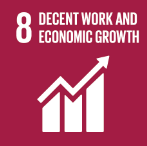SDG8 – Decent Work and Economic Growth

New Vocabulary
- economy
- social protection
- labour
- market
- decent
- standard of living
- economic growth
- violate
- rights
Practice the new vocabulary
Decent Work and Economic Growth vocabulary (text version)
Match the words to their definitions
Words:
- social protection
- economic growth
- right
- economy
- labour
- decent
- violate
- standard of living
- market
Definitions:
- the system by which a country’s money and goods are produced and used.
- systems that help promote better employment, job security and safety, and protects income loss
- work or employment
- a particular country or area where a company sells its goods or where a particular type of goods is sold
- good or acceptable; satisfactory
- the amount of wealth, comfort, and other things that a particular person, group, or country has
- an increase in the value of goods and services produced in a country or area
- to disobey or do something against an official agreement, law, or principle
- something that you are morally, legally, or officially allowed to do or have
Check your answers in footnote[1]
Activity source: Decent Work and Economic Growth vocabulary by Virginia McHardy, CC BY-NC 4.0
Decent Work and Economic Growth
According to the United Nations Department of Economic and Social Affairs (n.d.) Goal 8 Infographic: The United Nations would like to grow the economy for countries while at the same time making sure that every citizen has an equal opportunity for working in a reasonable job. However, there are still billions of people worldwide that are working in unsafe, temporary jobs with no social protection. The unemployment rate is getting better globally, except for those living in low-income countries. The inequality for women and young people can be seen in the labour market in regards to pay and decent work. This also affects the standard of living. If there is no economic growth, many people cannot afford the comforts of good food and/or shelter. The COVID-19 pandemic did not help this at all.
To add to the slow economic growth, many workers face unsafe conditions at their place of employment. Work accidents occur more times than they should. Companies around the world are violating labour rights without regard to human lives. In fact, in 11 out of 93 countries with data, more than 10 work-related fatalities per 100,000 workers were reported. This does not include the number of deaths that have gone unaccounted for.
Canadian Perspective
Goal 8, Decent Work and Economic Growth (text version)
Promote Sustained, Inclusive and Sustainable Economic Growth, Full and Productive Employment and Decent Work for All
Unemployment Rate
The unemployment rate was 7.5% for the total population in 2021. The rate for the Indigenous population was almost 55% higher.
The proportion of youth not in education, employment and training (NEET) increased almost 30% during the COVID-19 pandemic in 2020.
The Rate of Involuntary Part – Time Work
| Year | Annual % change for involuntary part-time work |
|---|---|
| 2019 | -10.4% |
| 2020 | 19.3% |
| 2021 | -8.4% |
In 2021, men aged 25-54 had the highest rate of involuntary part-time work. This was almost two times higher than the national average of 21%.
Economic Recovery From the Covid-19 Pandemic
| Industry | % change from September 2020 to September 2022 |
|---|---|
| Arts, entertainment and recreation | 70% |
| Food services and accommodations | 38% |
| Industry | change from September 2019 – September 2022 |
|---|---|
| Art, entertainment and recreation | -12% |
| Food services and accommodations | -9% |
Between 2020 – 2021, recent immigrants[3] recovered from unemployment faster than the total population.
Community Spotlight: Shorefast
Shorefast is a registered charity that builds economic and cultural resilience on Fogo Island, NL, and shares learning to help make it possible for local communities to thrive in the global economy. Shorefast’s programs comprise a holistic set of initiatives that hold relevance to community economic development.
Since the creation of Shorefast (2004)
- Employ ~33% of households on Fogo Island
- Estimated GDP impact of $55 million by 2023
- Share knowledge of community development beyond Fogo Island
Source(s): Statistics Canada, Labour Force Survey, 2021. Statistics Canada, Gross Domestic Product by Industry – National (Monthly), 2022. Shorefast, 2022.
Source: Goal 8, Decent Work and Economic Growth In Agenda 2030 Sustainable Development Goals Report, 2022 by Statistics Canada, used under Open License
Discussion Questions
Use the new vocabulary words in these discussion questions. Ask and answer in partners or small groups:
- How does a country’s economy affect the job opportunities available to its citizens?
- Why is social protection important for achieving decent work?
- What are some challenges that labour forces face in developing countries compared to developed ones?
- What are some pros and cons of participating in an international labour market?
- What does “decent work” mean to you, and how can we ensure more people have access to it?
- How does having a decent job affect a person’s standard of living?
- Are there any examples of policies in your country that have helped boost economic growth through employment?
- What should be the consequences for companies that violate labour laws?
- Why is it important to protect workers’ rights, and who should be responsible for doing so?
- Can you think of examples where workers fought for their rights successfully? What can we learn from those cases?
Watch the video:
Watch Goal 8 – Decent work and economic growth (1 mins) on YouTube
Video source: UNStats. (2022, July 7). Goal 8 – Decent work and economic growth [Video]. YouTube. https://www.youtube.com/watch?v=xCtuDnU1k3k
Activity source: Decent Work and Economic Growth video quiz by Virginia McHardy, CC BY-NC 4.0
Key Targets
- 8.1 Sustain per capita economic growth in accordance with national circumstances and, in particular, at least 7 per cent gross domestic product growth per annum in the least developed countries
- 8.2 Achieve higher levels of economic productivity through diversification, technological upgrading and innovation, including through a focus on high-value added and labour-intensive sectors
- 8.3 Promote development-oriented policies that support productive activities, decent job creation, entrepreneurship, creativity and innovation, and encourage the formalization and growth of micro-, small- and medium-sized enterprises, including through access to financial services
- 8.4 Improve progressively, through 2030, global resource efficiency in consumption and production and endeavour to decouple economic growth from environmental degradation, in accordance with the 10-Year Framework of Programmes on Sustainable Consumption and Production, with developed countries taking the lead
- 8.5 By 2030, achieve full and productive employment and decent work for all women and men, including for young people and persons with disabilities, and equal pay for work of equal value
- 8.6 By 2020, substantially reduce the proportion of youth not in employment, education or training
- 8.7 Take immediate and effective measures to eradicate forced labour, end modern slavery and human trafficking and secure the prohibition and elimination of the worst forms of child labour, including recruitment and use of child soldiers, and by 2025 end child labour in all its forms
- 8.8 Protect labour rights and promote safe and secure working environments for all workers, including migrant workers, in particular women migrants, and those in precarious employment
- 8.9 By 2030, devise and implement policies to promote sustainable tourism that creates jobs and promotes local culture and products
- 8.10 Strengthen the capacity of domestic financial institutions to encourage and expand access to banking, insurance and financial services for all
- 8.10a Increase Aid for Trade support for developing countries, in particular least developed countries, including through the Enhanced Integrated Framework for Trade-Related Technical Assistance to Least Developed Countries
- 8.10b By 2020, develop and operationalize a global strategy for youth employment and implement the Global Jobs Pact of the International Labour Organization
Source: United Nations Department of Economic and Social Affairs. (n.d.). Goal 8 [Infographic]. Sustainable Development Goals. https://sdgs.un.org/goals/goal8
Homework/Assignment:

Interview
- Interview someone (a family member, friend, or teacher) about their views on decent work or economic growth. Ask at least three questions, such as:
- What does decent work mean to you?
- What challenges do workers face in your community?
- How do you think governments or businesses can improve working conditions?
- Record key points of their answers to share in class.
You can read more about Goal #8 in The Sustainable Development Goals Report 2022 from the UN.:
For instructors, please visit York University’s The SDGs-in-the-Classroom Toolkit for lesson ideas
Attribution & References
Except where otherwise noted, this page is created by Virginia McHardy, CC BY-NC 4.0
References
United Nations Department of Economic and Social Affairs. (n.d.). Goal 8 [Infographic]. Sustainable Development Goals. https://sdgs.un.org/goals/goal8
- 1. economy 2. social protection 3. labour 4. market 5. decent 6. standard of living 7. economic growth 8. violate 9. right ↵
- The rate of involuntary part-time is based on all involuntary part-time workers, whether they looked for full-time work or not. The rate is then presented as the number of involuntary part-timers as a share of the part-time employed. ↵
- Recent Immigrants refers to people who are, or have been, landed immigrants in Canada for 5 years or less. A landed immigrant is a person who has been granted the right to live in Canada permanently by immigration authorities. ↵
the system by which a country’s money and goods are produced and used
a set of programs to help reduce poverty
work or employment
a particular country or area where a company sells its goods or where a particular type of goods is sold
good or acceptable; satisfactory
the amount of wealth, comfort, and other things that a particular person, group, or country has
an increase in the value of goods and services produced in a country or area
to disobey or do something against an official agreement, law, or principle
something that you are morally, legally, or officially allowed to do or have

